Comparing the Ethical Philosophies: Plato and Aristotle's Theories
VerifiedAdded on 2023/04/08
|5
|1436
|313
Essay
AI Summary
This essay provides a comparative analysis of Plato's "Allegory of the Cave" and Aristotle's "Nicomachean Ethics," exploring their perspectives on human life, knowledge, and happiness. It examines Plato's emphasis on philosophical reasoning to attain true knowledge versus sensory perception, as illustrated by the allegory of prisoners in a cave. The essay also delves into Aristotle's exploration of the good life and virtues, highlighting the significance of reason and ethical actions in achieving happiness. While both philosophers share the common goal of improving human life, their approaches differ, with Plato advocating for logical thinking and exploration of reality, and Aristotle emphasizing ethics and virtues. Ultimately, the essay concludes that both thinkers believed in the importance of virtue in achieving a fulfilling and happy life, achievable through Desklib's resources.
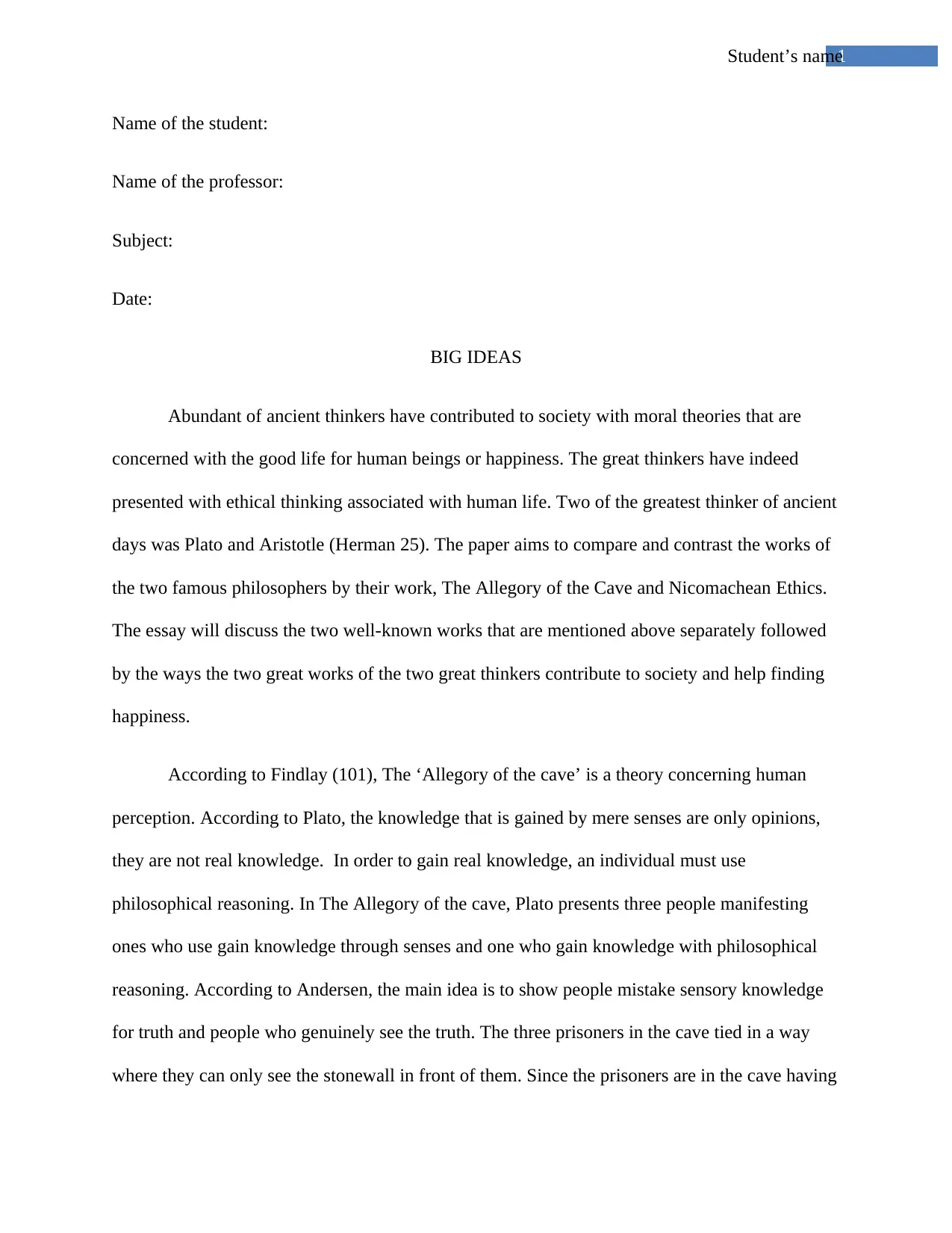
1Student’s name
Name of the student:
Name of the professor:
Subject:
Date:
BIG IDEAS
Abundant of ancient thinkers have contributed to society with moral theories that are
concerned with the good life for human beings or happiness. The great thinkers have indeed
presented with ethical thinking associated with human life. Two of the greatest thinker of ancient
days was Plato and Aristotle (Herman 25). The paper aims to compare and contrast the works of
the two famous philosophers by their work, The Allegory of the Cave and Nicomachean Ethics.
The essay will discuss the two well-known works that are mentioned above separately followed
by the ways the two great works of the two great thinkers contribute to society and help finding
happiness.
According to Findlay (101), The ‘Allegory of the cave’ is a theory concerning human
perception. According to Plato, the knowledge that is gained by mere senses are only opinions,
they are not real knowledge. In order to gain real knowledge, an individual must use
philosophical reasoning. In The Allegory of the cave, Plato presents three people manifesting
ones who use gain knowledge through senses and one who gain knowledge with philosophical
reasoning. According to Andersen, the main idea is to show people mistake sensory knowledge
for truth and people who genuinely see the truth. The three prisoners in the cave tied in a way
where they can only see the stonewall in front of them. Since the prisoners are in the cave having
Name of the student:
Name of the professor:
Subject:
Date:
BIG IDEAS
Abundant of ancient thinkers have contributed to society with moral theories that are
concerned with the good life for human beings or happiness. The great thinkers have indeed
presented with ethical thinking associated with human life. Two of the greatest thinker of ancient
days was Plato and Aristotle (Herman 25). The paper aims to compare and contrast the works of
the two famous philosophers by their work, The Allegory of the Cave and Nicomachean Ethics.
The essay will discuss the two well-known works that are mentioned above separately followed
by the ways the two great works of the two great thinkers contribute to society and help finding
happiness.
According to Findlay (101), The ‘Allegory of the cave’ is a theory concerning human
perception. According to Plato, the knowledge that is gained by mere senses are only opinions,
they are not real knowledge. In order to gain real knowledge, an individual must use
philosophical reasoning. In The Allegory of the cave, Plato presents three people manifesting
ones who use gain knowledge through senses and one who gain knowledge with philosophical
reasoning. According to Andersen, the main idea is to show people mistake sensory knowledge
for truth and people who genuinely see the truth. The three prisoners in the cave tied in a way
where they can only see the stonewall in front of them. Since the prisoners are in the cave having
Paraphrase This Document
Need a fresh take? Get an instant paraphrase of this document with our AI Paraphraser
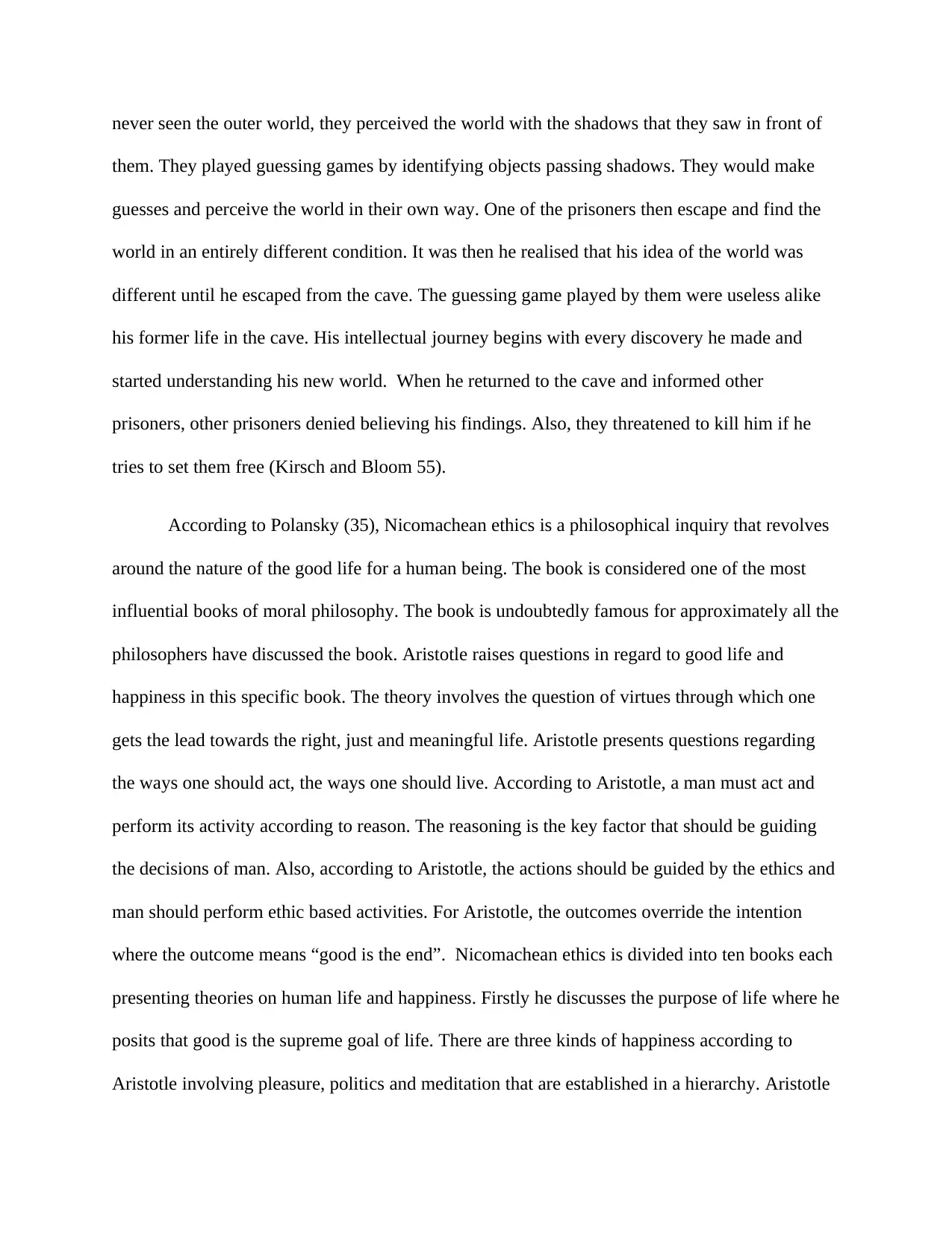
never seen the outer world, they perceived the world with the shadows that they saw in front of
them. They played guessing games by identifying objects passing shadows. They would make
guesses and perceive the world in their own way. One of the prisoners then escape and find the
world in an entirely different condition. It was then he realised that his idea of the world was
different until he escaped from the cave. The guessing game played by them were useless alike
his former life in the cave. His intellectual journey begins with every discovery he made and
started understanding his new world. When he returned to the cave and informed other
prisoners, other prisoners denied believing his findings. Also, they threatened to kill him if he
tries to set them free (Kirsch and Bloom 55).
According to Polansky (35), Nicomachean ethics is a philosophical inquiry that revolves
around the nature of the good life for a human being. The book is considered one of the most
influential books of moral philosophy. The book is undoubtedly famous for approximately all the
philosophers have discussed the book. Aristotle raises questions in regard to good life and
happiness in this specific book. The theory involves the question of virtues through which one
gets the lead towards the right, just and meaningful life. Aristotle presents questions regarding
the ways one should act, the ways one should live. According to Aristotle, a man must act and
perform its activity according to reason. The reasoning is the key factor that should be guiding
the decisions of man. Also, according to Aristotle, the actions should be guided by the ethics and
man should perform ethic based activities. For Aristotle, the outcomes override the intention
where the outcome means “good is the end”. Nicomachean ethics is divided into ten books each
presenting theories on human life and happiness. Firstly he discusses the purpose of life where he
posits that good is the supreme goal of life. There are three kinds of happiness according to
Aristotle involving pleasure, politics and meditation that are established in a hierarchy. Aristotle
them. They played guessing games by identifying objects passing shadows. They would make
guesses and perceive the world in their own way. One of the prisoners then escape and find the
world in an entirely different condition. It was then he realised that his idea of the world was
different until he escaped from the cave. The guessing game played by them were useless alike
his former life in the cave. His intellectual journey begins with every discovery he made and
started understanding his new world. When he returned to the cave and informed other
prisoners, other prisoners denied believing his findings. Also, they threatened to kill him if he
tries to set them free (Kirsch and Bloom 55).
According to Polansky (35), Nicomachean ethics is a philosophical inquiry that revolves
around the nature of the good life for a human being. The book is considered one of the most
influential books of moral philosophy. The book is undoubtedly famous for approximately all the
philosophers have discussed the book. Aristotle raises questions in regard to good life and
happiness in this specific book. The theory involves the question of virtues through which one
gets the lead towards the right, just and meaningful life. Aristotle presents questions regarding
the ways one should act, the ways one should live. According to Aristotle, a man must act and
perform its activity according to reason. The reasoning is the key factor that should be guiding
the decisions of man. Also, according to Aristotle, the actions should be guided by the ethics and
man should perform ethic based activities. For Aristotle, the outcomes override the intention
where the outcome means “good is the end”. Nicomachean ethics is divided into ten books each
presenting theories on human life and happiness. Firstly he discusses the purpose of life where he
posits that good is the supreme goal of life. There are three kinds of happiness according to
Aristotle involving pleasure, politics and meditation that are established in a hierarchy. Aristotle
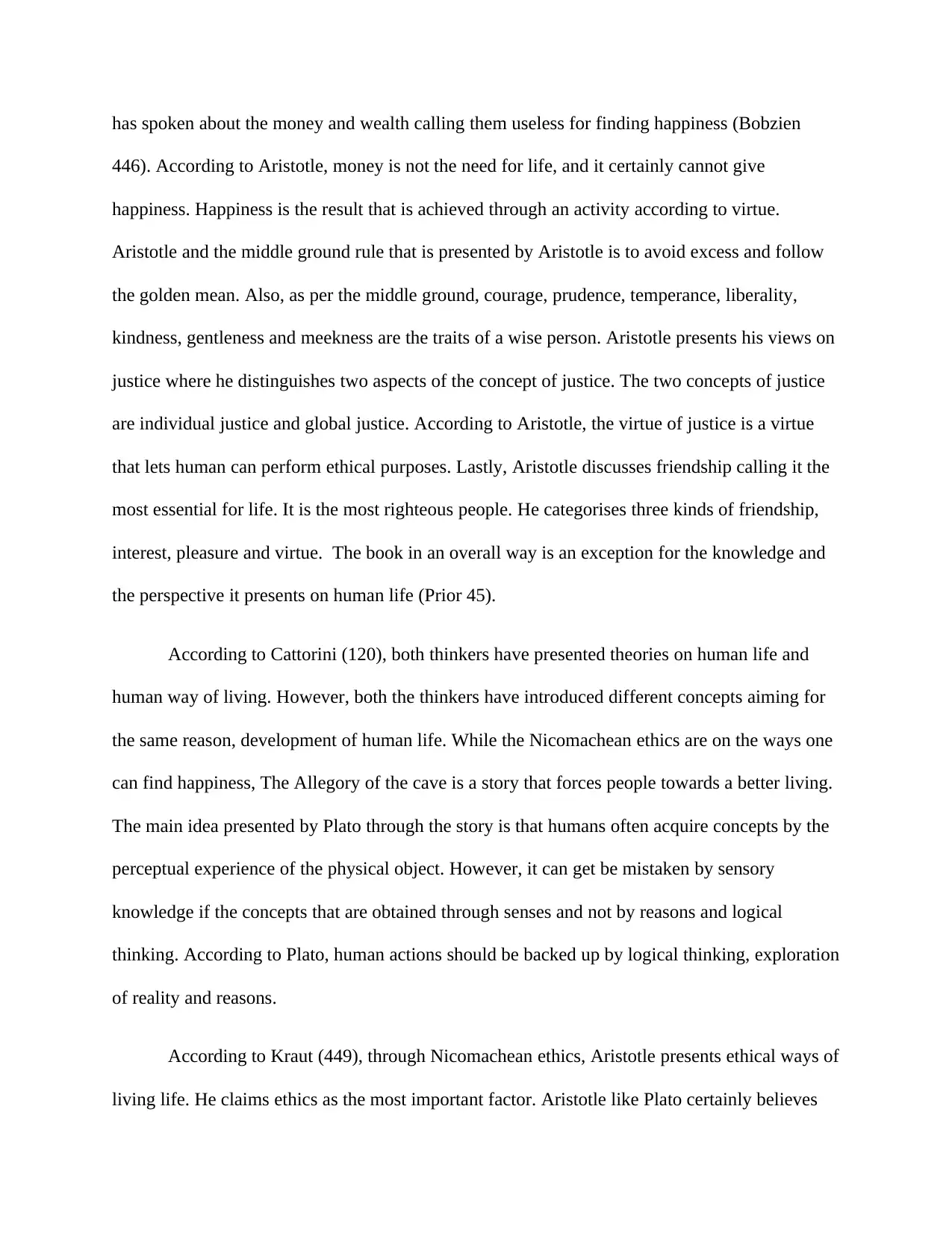
has spoken about the money and wealth calling them useless for finding happiness (Bobzien
446). According to Aristotle, money is not the need for life, and it certainly cannot give
happiness. Happiness is the result that is achieved through an activity according to virtue.
Aristotle and the middle ground rule that is presented by Aristotle is to avoid excess and follow
the golden mean. Also, as per the middle ground, courage, prudence, temperance, liberality,
kindness, gentleness and meekness are the traits of a wise person. Aristotle presents his views on
justice where he distinguishes two aspects of the concept of justice. The two concepts of justice
are individual justice and global justice. According to Aristotle, the virtue of justice is a virtue
that lets human can perform ethical purposes. Lastly, Aristotle discusses friendship calling it the
most essential for life. It is the most righteous people. He categorises three kinds of friendship,
interest, pleasure and virtue. The book in an overall way is an exception for the knowledge and
the perspective it presents on human life (Prior 45).
According to Cattorini (120), both thinkers have presented theories on human life and
human way of living. However, both the thinkers have introduced different concepts aiming for
the same reason, development of human life. While the Nicomachean ethics are on the ways one
can find happiness, The Allegory of the cave is a story that forces people towards a better living.
The main idea presented by Plato through the story is that humans often acquire concepts by the
perceptual experience of the physical object. However, it can get be mistaken by sensory
knowledge if the concepts that are obtained through senses and not by reasons and logical
thinking. According to Plato, human actions should be backed up by logical thinking, exploration
of reality and reasons.
According to Kraut (449), through Nicomachean ethics, Aristotle presents ethical ways of
living life. He claims ethics as the most important factor. Aristotle like Plato certainly believes
446). According to Aristotle, money is not the need for life, and it certainly cannot give
happiness. Happiness is the result that is achieved through an activity according to virtue.
Aristotle and the middle ground rule that is presented by Aristotle is to avoid excess and follow
the golden mean. Also, as per the middle ground, courage, prudence, temperance, liberality,
kindness, gentleness and meekness are the traits of a wise person. Aristotle presents his views on
justice where he distinguishes two aspects of the concept of justice. The two concepts of justice
are individual justice and global justice. According to Aristotle, the virtue of justice is a virtue
that lets human can perform ethical purposes. Lastly, Aristotle discusses friendship calling it the
most essential for life. It is the most righteous people. He categorises three kinds of friendship,
interest, pleasure and virtue. The book in an overall way is an exception for the knowledge and
the perspective it presents on human life (Prior 45).
According to Cattorini (120), both thinkers have presented theories on human life and
human way of living. However, both the thinkers have introduced different concepts aiming for
the same reason, development of human life. While the Nicomachean ethics are on the ways one
can find happiness, The Allegory of the cave is a story that forces people towards a better living.
The main idea presented by Plato through the story is that humans often acquire concepts by the
perceptual experience of the physical object. However, it can get be mistaken by sensory
knowledge if the concepts that are obtained through senses and not by reasons and logical
thinking. According to Plato, human actions should be backed up by logical thinking, exploration
of reality and reasons.
According to Kraut (449), through Nicomachean ethics, Aristotle presents ethical ways of
living life. He claims ethics as the most important factor. Aristotle like Plato certainly believes
⊘ This is a preview!⊘
Do you want full access?
Subscribe today to unlock all pages.

Trusted by 1+ million students worldwide
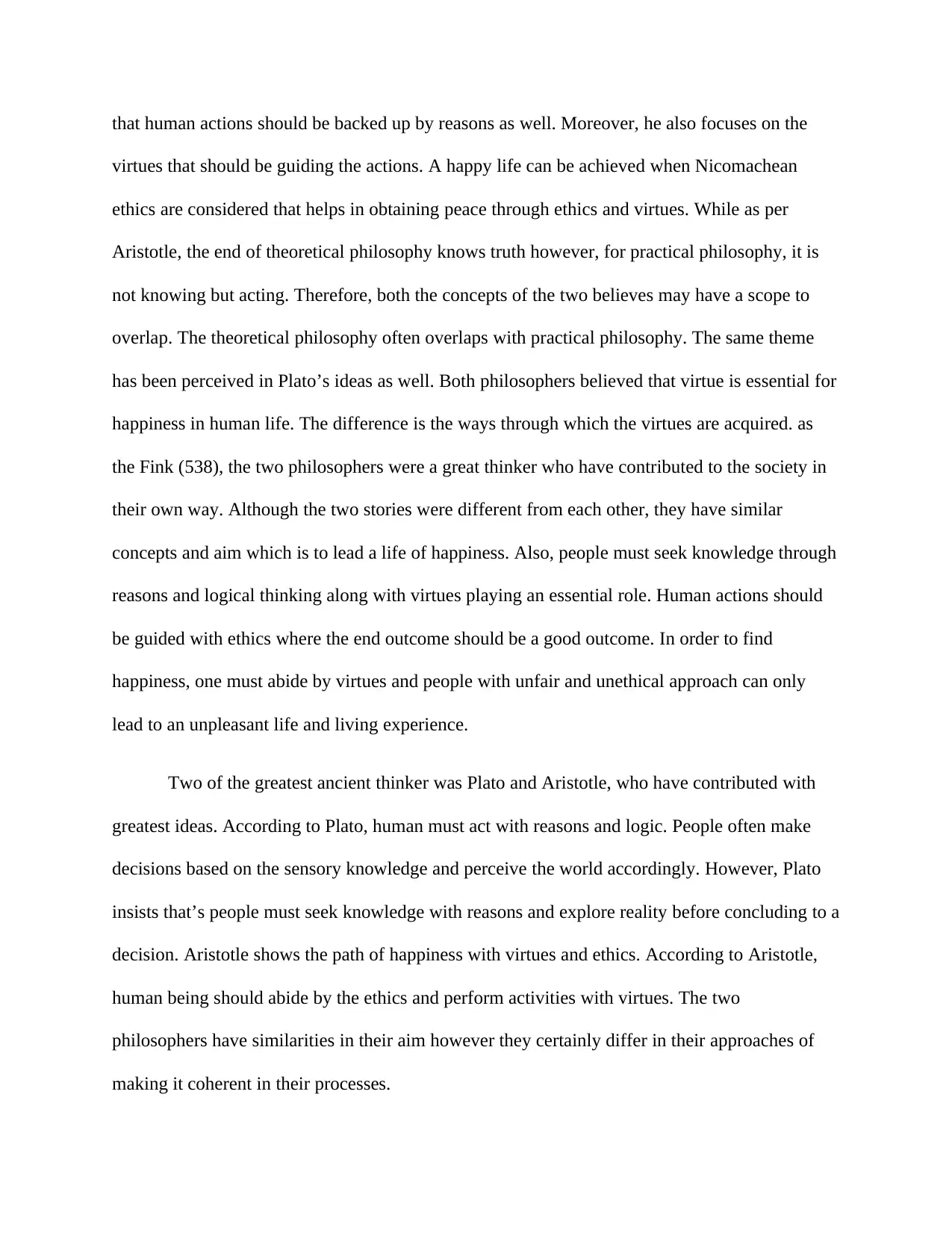
that human actions should be backed up by reasons as well. Moreover, he also focuses on the
virtues that should be guiding the actions. A happy life can be achieved when Nicomachean
ethics are considered that helps in obtaining peace through ethics and virtues. While as per
Aristotle, the end of theoretical philosophy knows truth however, for practical philosophy, it is
not knowing but acting. Therefore, both the concepts of the two believes may have a scope to
overlap. The theoretical philosophy often overlaps with practical philosophy. The same theme
has been perceived in Plato’s ideas as well. Both philosophers believed that virtue is essential for
happiness in human life. The difference is the ways through which the virtues are acquired. as
the Fink (538), the two philosophers were a great thinker who have contributed to the society in
their own way. Although the two stories were different from each other, they have similar
concepts and aim which is to lead a life of happiness. Also, people must seek knowledge through
reasons and logical thinking along with virtues playing an essential role. Human actions should
be guided with ethics where the end outcome should be a good outcome. In order to find
happiness, one must abide by virtues and people with unfair and unethical approach can only
lead to an unpleasant life and living experience.
Two of the greatest ancient thinker was Plato and Aristotle, who have contributed with
greatest ideas. According to Plato, human must act with reasons and logic. People often make
decisions based on the sensory knowledge and perceive the world accordingly. However, Plato
insists that’s people must seek knowledge with reasons and explore reality before concluding to a
decision. Aristotle shows the path of happiness with virtues and ethics. According to Aristotle,
human being should abide by the ethics and perform activities with virtues. The two
philosophers have similarities in their aim however they certainly differ in their approaches of
making it coherent in their processes.
virtues that should be guiding the actions. A happy life can be achieved when Nicomachean
ethics are considered that helps in obtaining peace through ethics and virtues. While as per
Aristotle, the end of theoretical philosophy knows truth however, for practical philosophy, it is
not knowing but acting. Therefore, both the concepts of the two believes may have a scope to
overlap. The theoretical philosophy often overlaps with practical philosophy. The same theme
has been perceived in Plato’s ideas as well. Both philosophers believed that virtue is essential for
happiness in human life. The difference is the ways through which the virtues are acquired. as
the Fink (538), the two philosophers were a great thinker who have contributed to the society in
their own way. Although the two stories were different from each other, they have similar
concepts and aim which is to lead a life of happiness. Also, people must seek knowledge through
reasons and logical thinking along with virtues playing an essential role. Human actions should
be guided with ethics where the end outcome should be a good outcome. In order to find
happiness, one must abide by virtues and people with unfair and unethical approach can only
lead to an unpleasant life and living experience.
Two of the greatest ancient thinker was Plato and Aristotle, who have contributed with
greatest ideas. According to Plato, human must act with reasons and logic. People often make
decisions based on the sensory knowledge and perceive the world accordingly. However, Plato
insists that’s people must seek knowledge with reasons and explore reality before concluding to a
decision. Aristotle shows the path of happiness with virtues and ethics. According to Aristotle,
human being should abide by the ethics and perform activities with virtues. The two
philosophers have similarities in their aim however they certainly differ in their approaches of
making it coherent in their processes.
Paraphrase This Document
Need a fresh take? Get an instant paraphrase of this document with our AI Paraphraser
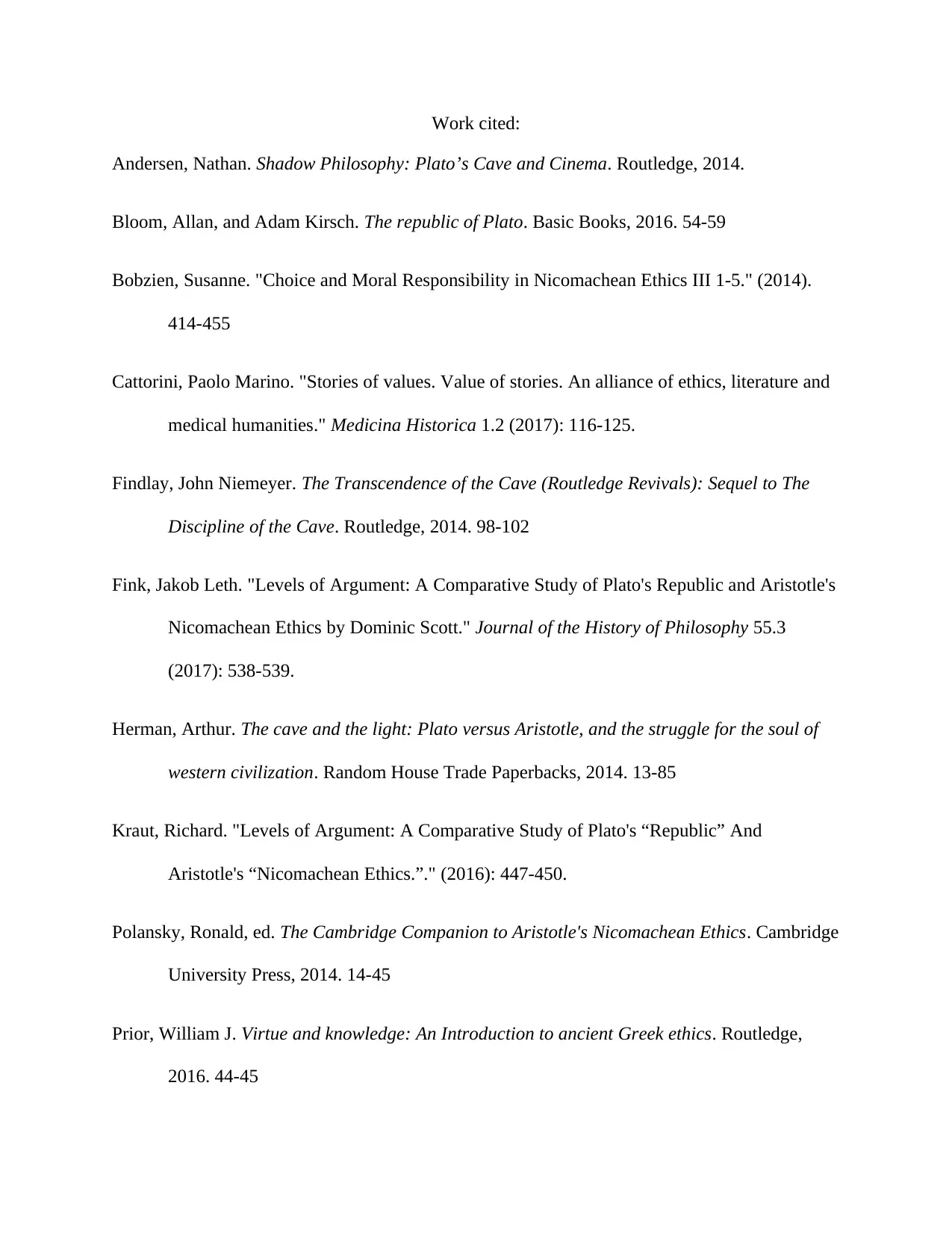
Work cited:
Andersen, Nathan. Shadow Philosophy: Plato’s Cave and Cinema. Routledge, 2014.
Bloom, Allan, and Adam Kirsch. The republic of Plato. Basic Books, 2016. 54-59
Bobzien, Susanne. "Choice and Moral Responsibility in Nicomachean Ethics III 1-5." (2014).
414-455
Cattorini, Paolo Marino. "Stories of values. Value of stories. An alliance of ethics, literature and
medical humanities." Medicina Historica 1.2 (2017): 116-125.
Findlay, John Niemeyer. The Transcendence of the Cave (Routledge Revivals): Sequel to The
Discipline of the Cave. Routledge, 2014. 98-102
Fink, Jakob Leth. "Levels of Argument: A Comparative Study of Plato's Republic and Aristotle's
Nicomachean Ethics by Dominic Scott." Journal of the History of Philosophy 55.3
(2017): 538-539.
Herman, Arthur. The cave and the light: Plato versus Aristotle, and the struggle for the soul of
western civilization. Random House Trade Paperbacks, 2014. 13-85
Kraut, Richard. "Levels of Argument: A Comparative Study of Plato's “Republic” And
Aristotle's “Nicomachean Ethics.”." (2016): 447-450.
Polansky, Ronald, ed. The Cambridge Companion to Aristotle's Nicomachean Ethics. Cambridge
University Press, 2014. 14-45
Prior, William J. Virtue and knowledge: An Introduction to ancient Greek ethics. Routledge,
2016. 44-45
Andersen, Nathan. Shadow Philosophy: Plato’s Cave and Cinema. Routledge, 2014.
Bloom, Allan, and Adam Kirsch. The republic of Plato. Basic Books, 2016. 54-59
Bobzien, Susanne. "Choice and Moral Responsibility in Nicomachean Ethics III 1-5." (2014).
414-455
Cattorini, Paolo Marino. "Stories of values. Value of stories. An alliance of ethics, literature and
medical humanities." Medicina Historica 1.2 (2017): 116-125.
Findlay, John Niemeyer. The Transcendence of the Cave (Routledge Revivals): Sequel to The
Discipline of the Cave. Routledge, 2014. 98-102
Fink, Jakob Leth. "Levels of Argument: A Comparative Study of Plato's Republic and Aristotle's
Nicomachean Ethics by Dominic Scott." Journal of the History of Philosophy 55.3
(2017): 538-539.
Herman, Arthur. The cave and the light: Plato versus Aristotle, and the struggle for the soul of
western civilization. Random House Trade Paperbacks, 2014. 13-85
Kraut, Richard. "Levels of Argument: A Comparative Study of Plato's “Republic” And
Aristotle's “Nicomachean Ethics.”." (2016): 447-450.
Polansky, Ronald, ed. The Cambridge Companion to Aristotle's Nicomachean Ethics. Cambridge
University Press, 2014. 14-45
Prior, William J. Virtue and knowledge: An Introduction to ancient Greek ethics. Routledge,
2016. 44-45
1 out of 5
Related Documents
Your All-in-One AI-Powered Toolkit for Academic Success.
+13062052269
info@desklib.com
Available 24*7 on WhatsApp / Email
![[object Object]](/_next/static/media/star-bottom.7253800d.svg)
Unlock your academic potential
Copyright © 2020–2025 A2Z Services. All Rights Reserved. Developed and managed by ZUCOL.





